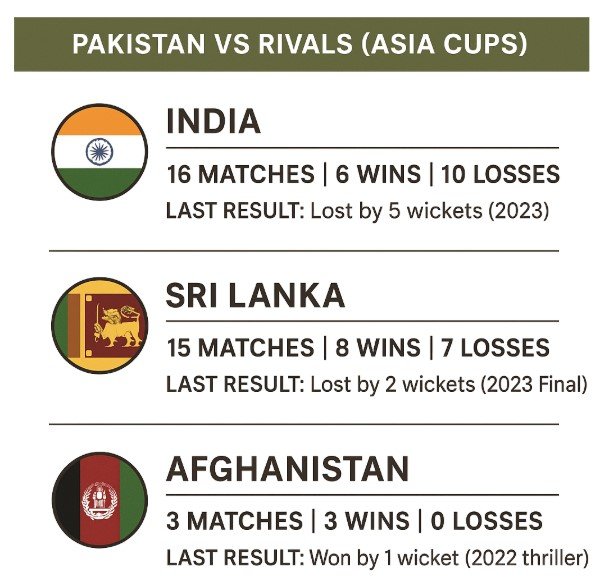When Pakistan begins their Asia Cup campaign in Dubai on September 12, they will do so under scrutiny unlike any in recent memory. More than a tournament, this edition feels like a referendum on direction. For a side that once thrived on unpredictability, the 2025 Asia Cup has become a test of nerve and reinvention. The central question: can Pakistan reclaim regional dominance without the stars who defined its last era?

A Squad Without Icons
The announcement of Pakistan’s 17-man squad left headlines burning. Babar Azam and Mohammad Rizwan, long the anchors of the batting order, were left out. Their consistency had carried Pakistan through many crises, yet selectors opted for a bold reset.
Coach Mike Hesson defended the move by pointing to numbers. Babar’s T20 strike rate of 129 no longer met the pace of modern cricket, while Rizwan’s steady approach often left the middle overs stalling. The new vision: relentless attack from the first ball.

Reactions have been polarising. Some praised the bravery of looking forward; others accused the board of discarding proven match winners. Former captain Mohammad Hafeez welcomed the shift, urging Pakistan to move beyond “safety first” batting. Kamran Akmal, however, warned that dropping players of Babar’s stature was folly. In every tea stall and talk show, the debate continues.
New Leadership, New Identity

Responsibility now rests with Salman Agha, a surprise pick as captain. Known more for grit than glamour, Salman represents a break from Pakistan’s tradition of star leaders. His role is clear: weld a young, aggressive side into a unit that can withstand pressure.
The top order reflects the new philosophy. Saim Ayub, elegant yet fearless, joins Fakhar Zaman, who remains Pakistan’s natural aggressor. Mohammad Haris brings audacity to the middle overs, with finishing left to emerging names rather than seasoned anchors. It is daring, but untested at the highest level.
Bowling, however, remains Pakistan’s bedrock. Shaheen Afridi leads with his trademark inswing, backed by the pace of Haris Rauf and newcomer Salman Mirza. On UAE pitches, spin will be vital, and selectors have stocked the squad with mystery options designed for sluggish surf- aces. In this department, at least, Pakistan’s confidence is intact.
India Looms Large
No fixture matters more than September 14, when Pakistan face India in Dubai. This contest transcends cricket, magnified by history and rivalry.
India arrive as defending champions, captained by Suryakumar Yadav, whose fearless batting epitomises modern T20 cricket. Their top order, with Shubman Gill and Abhishek Sharma, is deep and dynamic, while Jasprit Bumrah brings world-class authority with the ball.
For Pakistan, the stakes are heavier. A victory would silence criticism of the new selections and ignite belief. A heavy defeat, on the other hand, would validate those who called the squad overhaul reckless. The India clash is more than group points; it is the litmus test of Pakistan’s gamble.

Sri Lanka and Afghanistan: Silent Threats
While all eyes fix on India, Pakistan cannot afford to overlook its other rivals. Sri Lanka, masters of tournament cricket, thrive on resilience. With batters like Pathum Nisanka and a spin attack tailored for slow UAE pitches, they can squeeze opponents into submission. Pakistan’s fragile middle order will be under the microscope.
Afghanistan, meanwhile, is no longer an outsider. Led by Rashid Khan and Mujeeb ur Rahman, their bowling remains among the most potent in T20 cricket. Add the fearless batting of Rahmanullah Gurbaz, and Afghanistan has the tools to spring an upset. Pakistan knows this all too well; recent encounters have gone down to the final overs, exposing nerves under pressure.
The Gamble Defined
This Asia Cup is not just about lifting silverware. It is about testing a philosophy. By moving away from anchors and embracing firepower, Pakistan seeks to align with the demands of modern T20. Yet boldness without execution can unravel quickly.
There is historical precedent. India’s youth led T20 revolution in 2007 turned doubters into believers, while Australia’s generational reset under Mark Taylor reshaped their dominance. Pakistan’s selectors are betting on a similar breakthrough. But history also warns that revolutions falter when talent fails to deliver under pressure.
The Path to Redemption
For Pakistan to reassert dominance, three conditions must hold. They must land at least one win against India to prove the strategy credible. They must hold their nerve against Sri Lanka and Afghanistan, where slip-ups would be costly. And they must unearth within their new core a match-winner capable of owning big moments.
At present, Pakistan does not enter the Asia Cup as a favorite. They arrive as an enigma, dangerous, unproven, but alive with possibility. Perhaps that is where they have always been most threatening: underestimated, doubted, pushed into a corner.
In the desert heat of Dubai, Pakistan’s gamble will face its first true trial. Either it marks the beginning of a new chapter, or it forces a retreat to the comforts of the old guard. By the end of September, the region will know whether Pakistan’s reckoning has brought rebirth or regret.





